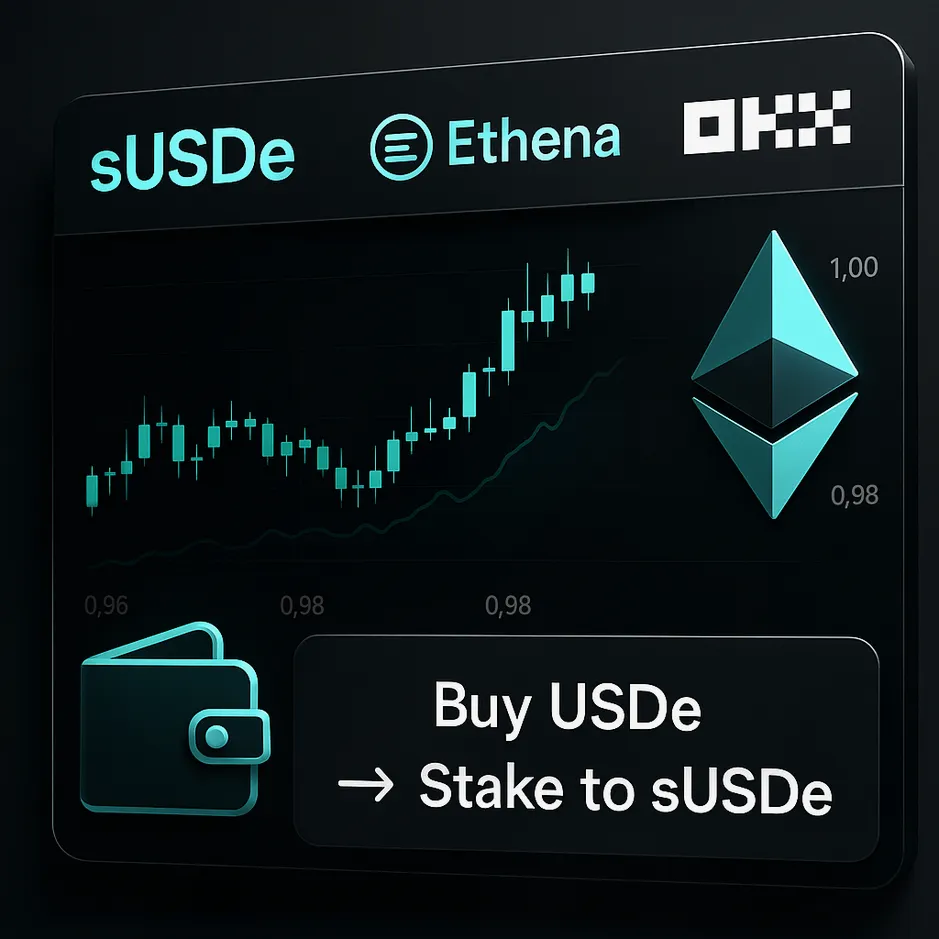If you’ve been tracking the rise of yield-bearing stablecoins, you’ve probably heard about Ethena’s staked USDe, known as sUSDe. This guide shows you exactly how to buy Ethena Staked USDe (sUSDe) through two practical paths: directly on an exchange if available, or on-chain via a wallet. We’ll use OKX as the hub for onboarding, funding, and self-custody options—and we’ll keep things friendly, precise, and beginner-safe.
Quick heads-up about the asset: USDe is Ethena’s synthetic dollar. When you stake USDe into sUSDe, your position is designed to accumulate protocol yield over time. Many investors like sUSDe for its transparent design and on-chain composability—but you still need to understand the risks, networks, and fees before you hit “buy.”
—
Quick answer
- Fastest way for most people: create an OKX account, add funds, then either trade sUSDe if it is listed in your region or use OKX’s Web3 tools to acquire USDe and stake it to sUSDe on-chain.
- Get started here: Join OKX with referral code CRYPTONEWER
—
What is sUSDe and why do people buy it
- sUSDe is the staked version of Ethena’s USDe. You deposit USDe and receive sUSDe, which is designed to accrue the protocol’s staking yield over time.
- It’s a yield-bearing stablecoin position that aims to keep dollar exposure while earning protocol-driven returns.
- sUSDe is typically used in DeFi strategies, liquidity pools, or held for passive accumulation.
Important: Yield, liquidity, and integrations change quickly. Always verify current APRs, contract addresses, and supported networks from the official Ethena documentation and reputable analytics sources.
—
What you need before buying sUSDe
- An OKX account and ID verification if required in your region
- A funding method: bank transfer, card, or crypto deposit (USDT, USDC, or ETH are common)
- A Web3 wallet for on-chain steps if you go the DeFi route (OKX provides a built-in Web3 Wallet)
- A small amount of ETH on the target network to pay gas if you use on-chain swaps and staking
Start here to streamline onboarding: Create your OKX account with referral code CRYPTONEWER
—
Path A Buy sUSDe directly on OKX if available in your region
Availability varies by country and time. If OKX lists sUSDe in your region, this is the most straightforward route.
1) Create and verify your account
– Go to OKX — use referral code CRYPTONEWER at sign-up
– Complete KYC as required for your jurisdiction
2) Deposit or buy USDT or other base assets
– Use deposit, bank transfer, or card purchase to fund with USDT, USDC, or fiat
3) Search for sUSDe
– In the spot trading interface, type sUSDe into the search bar
– If you see a pair like SUSDE/USDT, proceed; if not, use Path B
4) Place your trade
– Market order for speed, limit order for control
– Double-check the ticker, pair, and fees before confirming
5) Withdraw to self-custody if you plan to use DeFi
– For DeFi integrations, move sUSDe to your OKX Web3 Wallet or another self-custody wallet
Note: If you don’t find a spot pair or access is restricted, use the on-chain route below.
—
Path B Acquire sUSDe on-chain using OKX Web3 Wallet
This route works globally and is often preferred by DeFi users. The flow is simple: fund your account, move assets to a Web3 wallet, swap for USDe, then stake it to sUSDe on the Ethena dApp.
1) Onboard and fund on OKX
– Sign up here: OKX sign-up with code CRYPTONEWER
– Add funds: buy or deposit USDT/USDC/ETH
2) Set up the OKX Web3 Wallet
– In the OKX app or web platform, create a Web3 Wallet
– Secure your seed phrase and enable biometric or hardware wallet support where possible
3) Bridge or move assets to the right network
– Most USDe and sUSDe liquidity is on Ethereum mainnet and supported L2s; verify current networks
– Bridge funds as needed, and keep some ETH for gas
4) Swap for USDe via a DEX aggregator
– Open the OKX Web3 Wallet’s DEX section
– Choose a reputable liquidity source (e.g., Uniswap, Curve) via the aggregator
– Swap USDT/USDC/ETH to USDe
– Confirm slippage and gas before submitting
5) Stake USDe into sUSDe on the Ethena dApp
– Visit the official Ethena staking page from within the wallet browser
– Connect wallet, select Stake USDe, enter the amount, and confirm the transaction
– After confirmation, you’ll receive sUSDe in your wallet
6) Verify your sUSDe balance
– Add the correct sUSDe token address if it doesn’t auto-appear
– Track your position; sUSDe is designed to reflect yield accrual over time
—
Fees, slippage, and network tips
- Gas fees: Ethereum mainnet gas can spike; consider timing swaps or using L2s if supported
- Slippage: Liquidity for USDe is generally improving, but set a reasonable slippage limit, especially for large trades
- Exchange fees: Review OKX spot and withdrawal fees if using Path A
- Bridge costs: If you move across chains, expect bridge fees and delays
—
Safety checklist before you click confirm
- Official contracts only: Always verify the official USDe and sUSDe token addresses
- URL hygiene: Access Ethena and OKX from bookmarked official links
- Phishing awareness: Do not sign blind transactions; read approvals
- Wallet permissions: Periodically review and revoke unneeded approvals with a reputable tool
- Regional compliance: Ensure buying and staking are permitted in your jurisdiction
—
Troubleshooting common issues
- I can’t find sUSDe on OKX: Listings vary. Use the on-chain method with the OKX Web3 Wallet
- High gas fees: Wait for lower network congestion or use a supported L2 if available
- Poor DEX price: Try an alternative pool, split orders, or adjust slippage moderately
- sUSDe not showing in wallet: Add the token contract manually and refresh
- Failed transactions: Increase gas limit slightly or retry with updated nonce
—
Smart ways to use sUSDe after purchase
- Passive hold: Keep sUSDe in self-custody and let yield accrue over time
- DeFi strategies: Supply sUSDe to integrated protocols or liquidity pools if compatible
- Portfolio management: Balance stable yield positions against market volatility
Remember, yields, integrations, and risk profiles change. Always re-check the latest data before committing capital.
—
Why start with OKX for sUSDe
- Unified flow: Onboard, fund, swap, and stake with one ecosystem
- Web3 tools: Built-in wallet, DEX aggregator, and DeFi browser streamline the on-chain route
- Liquidity access: Easy pathways to USDT/USDC/ETH to acquire USDe
Start here for a smoother experience: OKX — use referral code CRYPTONEWER for sign-up
—
Frequently asked questions about buying Ethena Staked USDe sUSDe
-
Is sUSDe the same as USDe
- No. USDe is the base asset. sUSDe is the staked version that is designed to accrue yield
-
Do I need USDe before I get sUSDe
- Yes, typically you acquire USDe first, then stake it into sUSDe
-
Can I buy sUSDe directly on an exchange
- Sometimes, depending on listings and your region. If not available, use the on-chain route
-
What networks support sUSDe
- Primary liquidity is on Ethereum and supported L2s. Always verify current network support
-
What are the main risks
- Smart contract risk, liquidity risk, depeg risk, and market structure risk. Only transact with funds you can afford to risk
—
Recap checklist How to buy Ethena Staked USDe sUSDe
- Create account and fund: Join OKX with referral code CRYPTONEWER
- Path A: If listed, trade sUSDe on OKX and withdraw to your Web3 wallet if needed
- Path B: Use OKX Web3 Wallet to swap to USDe and stake to sUSDe on the Ethena dApp
- Manage gas, slippage, and approvals responsibly
—
This guide covered both centralized and on-chain options so you can buy Ethena Staked USDe (sUSDe) efficiently and with fewer mistakes. Whether you find a direct pair or take the DeFi route, starting with OKX for onboarding and Web3 access gives you a streamlined path to sUSDe while keeping control over your assets.
Not financial advice. Crypto involves risk, and stablecoin strategies are not risk-free. Research carefully and comply with your local regulations.





